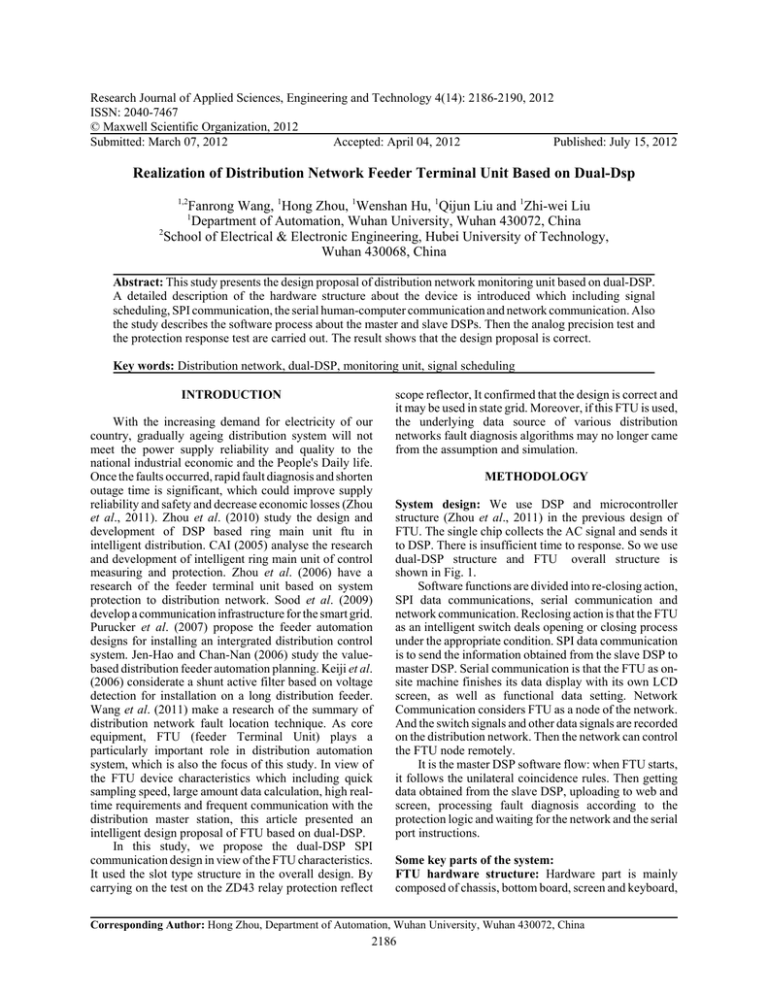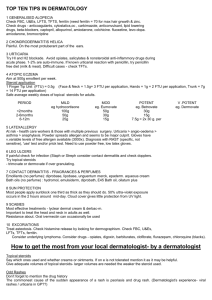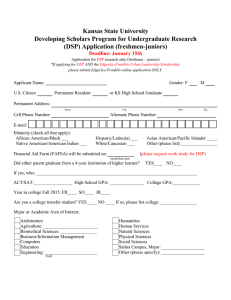Research Journal of Applied Sciences, Engineering and Technology 4(14): 2186-2190,... ISSN: 2040-7467
advertisement

Research Journal of Applied Sciences, Engineering and Technology 4(14): 2186-2190, 2012 ISSN: 2040-7467 © Maxwell Scientific Organization, 2012 Submitted: March 07, 2012 Accepted: April 04, 2012 Published: July 15, 2012 Realization of Distribution Network Feeder Terminal Unit Based on Dual-Dsp 1,2 Fanrong Wang, 1Hong Zhou, 1Wenshan Hu, 1Qijun Liu and 1Zhi-wei Liu Department of Automation, Wuhan University, Wuhan 430072, China 2 School of Electrical & Electronic Engineering, Hubei University of Technology, Wuhan 430068, China 1 Abstract: This study presents the design proposal of distribution network monitoring unit based on dual-DSP. A detailed description of the hardware structure about the device is introduced which including signal scheduling, SPI communication, the serial human-computer communication and network communication. Also the study describes the software process about the master and slave DSPs. Then the analog precision test and the protection response test are carried out. The result shows that the design proposal is correct. Key words: Distribution network, dual-DSP, monitoring unit, signal scheduling INTRODUCTION With the increasing demand for electricity of our country, gradually ageing distribution system will not meet the power supply reliability and quality to the national industrial economic and the People's Daily life. Once the faults occurred, rapid fault diagnosis and shorten outage time is significant, which could improve supply reliability and safety and decrease economic losses (Zhou et al., 2011). Zhou et al. (2010) study the design and development of DSP based ring main unit ftu in intelligent distribution. CAI (2005) analyse the research and development of intelligent ring main unit of control measuring and protection. Zhou et al. (2006) have a research of the feeder terminal unit based on system protection to distribution network. Sood et al. (2009) develop a communication infrastructure for the smart grid. Purucker et al. (2007) propose the feeder automation designs for installing an intergrated distribution control system. Jen-Hao and Chan-Nan (2006) study the valuebased distribution feeder automation planning. Keiji et al. (2006) considerate a shunt active filter based on voltage detection for installation on a long distribution feeder. Wang et al. (2011) make a research of the summary of distribution network fault location technique. As core equipment, FTU (feeder Terminal Unit) plays a particularly important role in distribution automation system, which is also the focus of this study. In view of the FTU device characteristics which including quick sampling speed, large amount data calculation, high realtime requirements and frequent communication with the distribution master station, this article presented an intelligent design proposal of FTU based on dual-DSP. In this study, we propose the dual-DSP SPI communication design in view of the FTU characteristics. It used the slot type structure in the overall design. By carrying on the test on the ZD43 relay protection reflect scope reflector, It confirmed that the design is correct and it may be used in state grid. Moreover, if this FTU is used, the underlying data source of various distribution networks fault diagnosis algorithms may no longer came from the assumption and simulation. METHODOLOGY System design: We use DSP and microcontroller structure (Zhou et al., 2011) in the previous design of FTU. The single chip collects the AC signal and sends it to DSP. There is insufficient time to response. So we use dual-DSP structure and FTU overall structure is shown in Fig. 1. Software functions are divided into re-closing action, SPI data communications, serial communication and network communication. Reclosing action is that the FTU as an intelligent switch deals opening or closing process under the appropriate condition. SPI data communication is to send the information obtained from the slave DSP to master DSP. Serial communication is that the FTU as onsite machine finishes its data display with its own LCD screen, as well as functional data setting. Network Communication considers FTU as a node of the network. And the switch signals and other data signals are recorded on the distribution network. Then the network can control the FTU node remotely. It is the master DSP software flow: when FTU starts, it follows the unilateral coincidence rules. Then getting data obtained from the slave DSP, uploading to web and screen, processing fault diagnosis according to the protection logic and waiting for the network and the serial port instructions. Some key parts of the system: FTU hardware structure: Hardware part is mainly composed of chassis, bottom board, screen and keyboard, Corresponding Author: Hong Zhou, Department of Automation, Wuhan University, Wuhan 430072, China 2186 Res. J. Appl. Sci. Eng. Technol., 4(14): 2186-2190, 2012 24C256 Ourside RAM clock Power watchd og TCP/IP RS232/48 5 PC com m unicat ion Practi cally Test ing Swi th input Optocoup ler DSP CPLD SPI Optocoup ler relay vo ltage current input Keyboard ? LCD Swith output Roll transl a ti on filter DSP Fig. 1: FTU overall stucture VBUS f l oor AB data bus power CPU Ac … Sampl i ng Remot e pl ugi n … Remot e cont r ol pl ugi n … Fig. 2: FTU hardware structure Signal scheduling: The system uses CPLD chip XC9536 in Xilinx Corporation to process the data transmission between CPU plug-in unit and AC sampling plug-in unit, remote signal plug-in unit, remote control plug-in unit. XC9536 primarily consists of the following three modules: function module, the I/O interface module and the interconnect matrix module (CAI, 2005). Among them, the function module realizes the CPLD logical processing, the I/O module provides CPLD the input and the output cushion, the interconnection matrix realizes the CPLD interior signal momentary connection (ZHOU 3.3V CPU CPLD VD D I/O 0 I/O 1 I/O 2 XC9536 I/O3 I/O4 GN D I/O V DD I/O0 I/O1 I/O2 I/O 3 I/O 4 VSS S3C2440A DATA D0-D15 I/O DATA latch master CPU plug-in unit, AC sampling plug-in unit, remote signal plug-in unit, remote control plug-in unit, power plug-in unit, as well as part of the composition. Using slot structure (Zhou et al., 2011), the bottom board has a power bus, an address bus and a data bus and connects the plug-in units. Each plug-in unit has relatively independent function. There are 14 slots on the bottom board. The first is power plug-in slot, the second is master CPU plug-in slot and the remaining 12 slots can be configured as AC sampling plug-in slot or remote control plug-in slot, the system has a strong scalability. Figure 2 shows FTU hardware structure and the main plug-in units are introduced as bellow. D0-D15 I/O Fig. 3: Signal scheduling connection diagram et al., 2006). Figure 3 shows the connection diagram of system signal scheduling. The CPU signal scheduling procedure is as follows: When the CPU needs the data of the AC sampling plug-in unit, it will first notify the CPLD to select this plug-in latch, so the plug-in can connect its data bus to the CPU data bus and the other plug-ins can not be connected. After the operation, CPLD control the plug-in latch to isolate its data bus from the CPU data bus. Thus the CPU 2187 Res. J. Appl. Sci. Eng. Technol., 4(14): 2186-2190, 2012 C PLD Begin XC9536 I/O I/O DSP CS S CK SDI S DO SPI data CPU I/O DSP N CS SC K S DO S DI Frame is head? Y N Fig. 4: SPI connection of master-slave DSPs SPI program flow is as follows: slave DSP opens a data buffer in the program to store the computed data after ADC module sampling. AC sampling plug-in unit uses the slave DSP to sample the voltage and current data and then convert these data into effective value. When the master DSP needs data, it enables the slave DSP to translate with it. After receiving data, the master DSP firstly determines whether the received data is valid data or not by the header, then determines whether it is a valid command header or data header. After calibration, the master DSP continue the remained steps according to the SPI program flow shown in Fig. 5. Local machine communication: This system uses the LCD screen based on the RS-232 interface and DSP to finish the local machine communication. Users can easily see the feeder lines running stats, analog measurement and switch situation on spot. And users can operate the switch via key buttons. It uses the SCI module of S3C2440A chip (Jen-Hao and Chan-Nan, 2006) whose GPIOH interfaces can be used as serial communication port. It use the MAX232 to complete the system level N Data frame head? N Y can control any plug-in unit without affecting the other plug-in units and it can finish signal scheduling perfectly. SPI communication: SPI, the Serial Peripheral Interface, has introduced a high-speed, full-duplex synchronous serial communication bus (Sood et al., 2009). It woks in master/slave mode and supports a master device to communicate with one or more salve devices. Its pins on the chip take up only four lines, namely: SDI, SDO, SCK and CS. SCK is a system serial communication clock signal which is controlled by the master device. SDI and SDO are data input and output pins, which is based on the square wave signal of SCK to complete the data transmission. CS is the enable pin of the slave device which is controlled by CPLD (Purucker et al., 2007). Figure 4 is the SPI communication hardware connection diagram of master -slave DSPs. The CS strobe of salve DSP is controlled by the CPLD. When the CS signal of the slave device is low, the chip can receive data on the SPI or send data to the SPI bus. SPI is a full-duplex communication, allowing data input and output at the same time. Command frame head? Y Receive the command frame N BFSR Check code right Check code right N Y Y Processing order frame Processing order frame End Fig. 5: SPI communication program flow S3C2 440A MAX232 TXD0/GPH2 R1OUT T1OUT RXD0/GPH3 T1IN TXD1/GPH4 R2OUT T2 OUT RXD1/GPH5 T2IN R1 IN R2 IN s er i al por t 0 ser i al por t 1 Fig. 6: Local machine hardware connection And Circulation shows The load food single Real time data Safety setting First data second data swith data Transformer protection System parameter Line parameter Logout Protection Fig. 7: Local machine software structure conversion betweenRS232 and TTL. Figure 6 is showing the connection diagram between S3C2440A and MAX232. And LCD software menu structure is shown in Fig. 7. 2188 Res. J. Appl. Sci. Eng. Technol., 4(14): 2186-2190, 2012 Table 1: FTU measurement data Parameter Normalized ID type value 1 voltage 5V 2 voltage 10V 3 voltage 20V 4 voltage 50V 5 voltage 100V 6 current 0.5A 7 current 1A 8 current 5A 9 current 10A 10 current 40A 11 frequency 50Hz 12 frequency 60Hz Measured value 4.92V 10.14V 19.90V 49.81V 100.86V 0.51A 1.01A 4.96A 9.92A 39.62A 49.98Hz 60.03Hz Absolute error 0.08V 0.14V 0.1V 0.19V 0.86V 0.01A 0.01A 0.04A 0.08A 0.38A 0.02Hz 0.03Hz Table 2: Current protection test data Speed concluded Operating ID that value (A) value (A) 1 5 5.05 2 5 5.10 3 10 10.10 4 10 10.10 5 20 20.40 6 20 20.20 7 50 50.00 8 50 50.50 Relative error (%) 1.6 1.4 0.5 0.38 0.86 2 1 0.8 0.8 0.95 0.04 0.05 Value setting menu contains setting and viewing the relay logic parameters, authorized users can easily adjust some FTU relay logic through the menu and these parameters can be uploaded to distribution main station. Also this interface provides an event logging on the system. Users can find what time and what type of relay protection action that the FTU had started over through this menu, helping maintenance person to find the cause of the failure, providing the basis for excluding line fault. Test data and analysis: On the ZD43 relay protection test instrument platform, this article mainly tests analog measurement precision, logical reaction and tripping speed. Analog measurement precision test: Voltage, current, frequency measurements are shown as Table 1. Voltage absolute error of this FTU system is less than 1V. And Current absolute error is less than 0.5A. The relative error is smaller than 2%. Because the FTU used the DSP capture unit to measure Frequency, it has obtained a higher precision, the absolute error is smaller than 0.05Hz and the relative error is smaller than 0.1%. Furthermore, active/reactive power, power factor and other parameters are measured and the experiment results show that the FTU will meet the appropriate requirements. Protection action response test: Current protection test datas are shown as Table 2. Relay protection, there is a quick-break protection, extension speed of trip protection, over-current protection, over voltage and low voltage protection and other protection logic. In the designing of FTU, these protection objective is that when external input signals comply with these conditions of protection logic, FTU can quickly drive on the remote control plugin relays to trip or closing, so that external electrical equipment, such as circuit breakers, produce an appropriate opening actions in order to achieve the goal of fault isolation or line status adjustment. Current protection test data can be seen in the above table, FTU action error between current value and setting Return value (A) 4.95 4.95 10.00 9.90 20.00 19.80 49.00 49.50 Relative error (%) 1 2 1 1 2 1 0 1 Response (ms) 37.473 32.565 37.824 31.971 30.468 32.579 35.127 31.853 value is less than 3%. It meets the requirement of less than 5% in relay protection action and current instantaneous response time is less than 40 ms which included the remote control panel relay inherent pull-in time. CONCLUSION AND DISCUSSION This study proposed dual-DSP SPI communication design in view of the FTU characteristics. It used the slot type structure in the overall design. By carrying on the test on the ZD43 relay protection reflect scope reflector, It confirmed that the design is correct and it may be used in state grid. Successful application of the FTU will make greater contributions to distribution network fault location (Wang et al., 2011) and recovery. In the current distribution network fault diagnosis methods such as matrix algorithm and artificial intelligence algorithm, their preconditions are assumed that they got a large number of nodes information in the distribution and then made the theoretical derivation and simulation calculations and they largely didn’t take into account the actual site status. If this FTU is used, the underlying data source of various distribution networks fault diagnosis algorithms may no longer came from the assumption and simulation. ACKNOWLEDGMENT The authors wish to thank the helpful comments and suggestions from teachers and colleagues in modeling and control Lab in department of automation. This study is supported by the fundamental research funds for the central universities (208275642). REFERENCES CAI, S., 2005. Research and development of intelligent ring main unit of control measuring and protection. Electr. Pow. Automat. Equip., 25: 24-25. Jen-Hao, T. and L. Chan-Nan, 2006. Value-based distribution feeder automation planning. Int. J. Electric. Power, 28: 186-194. Keiji, W., F. Hideaki and A. Hirofumi, 2006. Considerations of a shunt active filter based on voltage detection for installation on a long distribution feeder. IEEE T. Ind. Appl., 38: 1123-1130. 2189 Res. J. Appl. Sci. Eng. Technol., 4(14): 2186-2190, 2012 Purucker, S.L., R.J. Thomas and L.D. Monteen, 2007. Feeder automation designs for installing an intergrated distribution control system. IEEE T. Power Apparatus Syst.., 104: 2929-2934. Sood, K., D. Fischer and J.M. Eklund, 2009. Developing a Communication Infrastructure for the Smart Grid. IEEE Electrical Power and Energy Conference, pp: 1-7. Wang, F., H. Zhou, H. Wenshan and Q. Deng, 2011. Summary of distribution network fault location technique. Proceeding of International Conference on Electrical and Control Engineering, pp: 2604-2609. Zhou, N., J.I.A. Yanhai and Z. Yuan, 2006. Feeder terminal unit based on system protection to distribution network. Automat. Electr. Pow. Syst., 30: 94-97. Zhou, H., L. Xing and Q. Deng, 2010. The Design and Development of DSP Based Ring Main Unit FTU in Intelligent Distribution. Proceeding of International Conference on Electrical and Control Engineering, pp: 2299-2302. Zhou, H., L. Xing and Q. Deng, 2011. Design of DSPbased FTU for RMU of intelligent distribution grid. Electr. Pow. Automat. Equip., 31: 124-128. 2190



